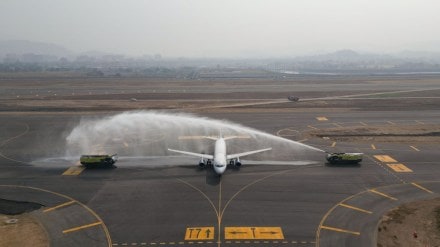The long-anticipated Navi Mumbai International Airport (NMIA) is set to be inaugurated on April 17, 2025, marking a pivotal milestone for the Mumbai Metropolitan Region (MMR). This development promises to address the growing air travel demand and alleviate congestion at Mumbai’s Chhatrapati Shivaji Maharaj International Airport.
Successful Trial Landing Paves the Way
On Sunday, NMIA witnessed its first commercial aircraft landing—a significant milestone toward its operational readiness. An Indigo A320 successfully touched down on the newly built 08/26 runway, welcomed by a ceremonial water salute.
Adani Airport Holdings Ltd CEO Arun Bansal announced that NMIA received the Air Operator Permit (AOP) on February 6, setting the stage for its inauguration 70 days later. The airport is now focused on securing an aerodrome license to commence full-scale operations.
State-of-the-Art Infrastructure
Spread across 1,160 hectares, NMIA is poised to become one of India’s largest greenfield international airports. Its initial phase includes:
- Terminal 1, is designed to handle 20 million passengers annually.
- Two parallel runways enable simultaneous and independent aircraft operations.
- Capacity to handle 60 million passengers and 1.5 million tonnes of cargo annually upon full completion.
Phase 2, commencing in mid-2025, will see the construction of Terminal 2, which will add capacity for another 30 million passengers annually, along with expanded cargo operations.
Boost to Local and Regional Economy
Residents of Navi Mumbai and nearby regions eagerly await the airport’s opening, which promises to be an economic catalyst for the area. Industries, particularly in Pune’s Chakan and Talegaon belts, are optimistic about the benefits of reduced travel time and enhanced connectivity.
- Logistics Hub: Cargo operations at NMIA will address long-standing challenges for exporters, especially those dealing with perishable goods.
- Passenger Convenience: For Pune residents, the reduced travel time to NMIA compared to Mumbai’s airport will make it a preferred choice for both domestic and international flights.
NMIA aims to be more than just an airport; it is envisioned as a key aviation hub. By 2029, the airport expects to serve 50 million passengers annually with both terminals operational. Its strategic location near the Mumbai-Pune Expressway ensures easy access for travellers.
A New Era for Maharashtra’s Aviation Sector
According to aviation analyst Dhairyashil Vandekar, NMIA will significantly impact air travel in western India, offering convenient international connections for passengers who currently rely on airports in Mumbai, Hyderabad, or Bangalore.
With a development cost of Rs 18,000 crore, NMIA is a public-private partnership between Adani Airports Holdings Ltd and CIDCO. It is named after Dinkar Balu Patil, a former MP who championed the rights of local communities during land acquisition protests.
Projected Timeline for Operations
- April 2025: Inauguration of NMIA.
- May 2025: Commencement of domestic operations.
- July 2025: Start of international flights, following regulatory approvals.
Transforming Air Travel and Logistics
The airport’s advanced infrastructure, including full-length taxiways and parking for 350 aircraft, positions it as a major player in global aviation. For Pune’s industries, NMIA promises reduced logistics costs and improved access to international markets, making it a boon for sectors like automotive, IT, and agriculture.
As NMIA prepares to open its doors, it is poised to redefine air travel in Maharashtra, strengthen India’s aviation capabilities, and drive regional economic growth.
